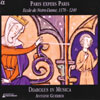Paris expers Paris - Ecole de Notre-Dame, 1170 - 1240
Polyphony from the medieval Parisian school of Notre-Dame
View record and artist detailsRecord and Artist Details
Composer or Director: Traditional, Anonymous, (composers) Various
Genre:
Vocal
Label: Alpha
Magazine Review Date: 1/2007
Media Format: CD or Download
Media Runtime: 69
Mastering:
Stereo
DDD
Catalogue Number: ALPHA102

Tracks:
| Composition | Artist Credit |
|---|---|
| Benedicamus Domino |
Anonymous, Composer
Anonymous, Composer Antoine Guerber, Conductor Diabolus in Musica Diabolus in Musica |
| Deus misertus hominis |
Anonymous, Composer
Anonymous, Composer Antoine Guerber, Conductor Diabolus in Musica Diabolus in Musica |
| Descendit de celis |
Traditional, Composer
Antoine Guerber, Conductor Diabolus in Musica Diabolus in Musica Traditional, Composer |
| Mundus vergens |
Anonymous, Composer
Anonymous, Composer Antoine Guerber, Conductor Diabolus in Musica Diabolus in Musica |
| O Maria virginei |
Anonymous, Composer
Anonymous, Composer Antoine Guerber, Conductor Diabolus in Musica Diabolus in Musica |
| Carmina Burana, Movement: Olim sudor Herculis CB 63 |
Anonymous, Composer
Anonymous, Composer Antoine Guerber, Conductor Diabolus in Musica Diabolus in Musica |
| Hortus Deliciarum, Movement: Veri floris sub figura (Hortus deliciarum) |
(composers) Various, Composer
(composers) Various, Composer Antoine Guerber, Conductor Diabolus in Musica Diabolus in Musica |
| Naturas deus regulis |
Anonymous, Composer
Anonymous, Composer Antoine Guerber, Conductor Diabolus in Musica Diabolus in Musica |
| Sursum corda |
Anonymous, Composer
Anonymous, Composer Antoine Guerber, Conductor Diabolus in Musica Diabolus in Musica |
Author: mberry
This is a fascinating selection of early polyphony from the great 11th- and 12th-century school of Notre-Dame in Paris. Some of it is sacred, with pieces relating to the Christmas season. Two items, the Vespers versicle Benedicamus Domino and the famous Matins responsory Descendit, are examples of three-part organum, with highly florid added parts accompanying a prodigiously slow-moving tenor (the basis of the structure – “holding” it together). Other items fall into the mainly syllabic and homophonic category of conductus, in two, three or four parts, with one single monophonic piece. The male-voice ensemble, with their intriguing title Diabolus in Musica (the tritone), embark upon a voyage of exploration – they go right to the heart of an exciting era of musical development when musicians, notably the leaders, Léonin and Pérotin, were exploring the very essence of sound and the blending of sounds, rhythms and vocal timbres. The recording was made in the magnificent abbey of Fontevraud. But why hadn’t the singers chosen Notre-Dame itself for their experimentation, so as to get nearer to the actual acoustic in which the Magnus liber organi composers were operating? In the 1950s, during an early music conference in Paris, we delegates were privileged to enjoy the personal experience of performing some of this music in the spacious resonance of that building.
It is stimulating to hear the Diabolus cantor intoning with superexcellence, demonstrating the kind of medieval elaboration we believe to have been used by proud singers of the time, anxious to show off their fine voices.
It is stimulating to hear the Diabolus cantor intoning with superexcellence, demonstrating the kind of medieval elaboration we believe to have been used by proud singers of the time, anxious to show off their fine voices.
Discover the world's largest classical music catalogue with Presto Music.

Gramophone Digital Club
- Digital Edition
- Digital Archive
- Reviews Database
- Full website access
From £8.75 / month
Subscribe
Gramophone Full Club
- Print Edition
- Digital Edition
- Digital Archive
- Reviews Database
- Full website access
From £11.00 / month
Subscribe
If you are a library, university or other organisation that would be interested in an institutional subscription to Gramophone please click here for further information.




